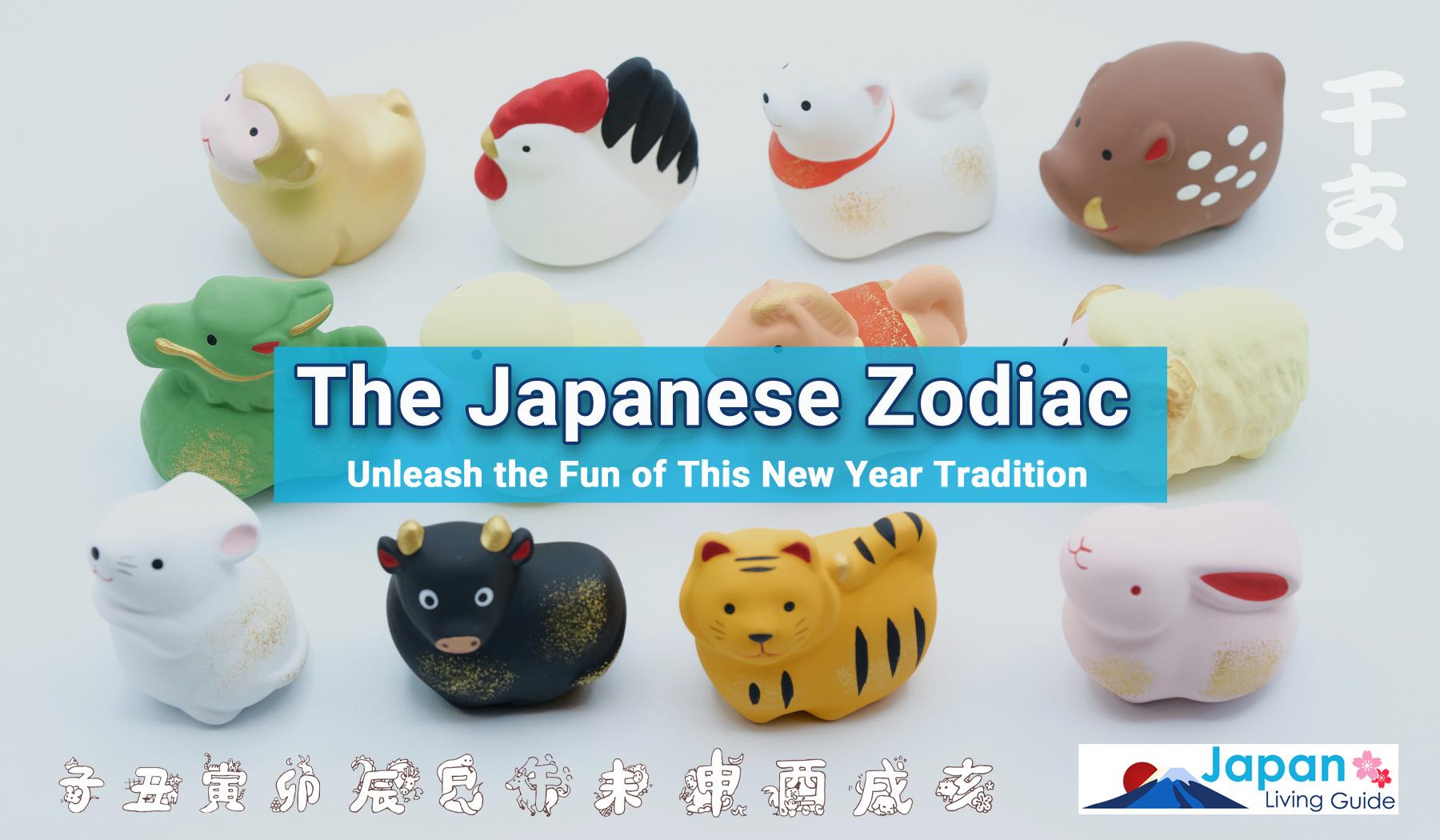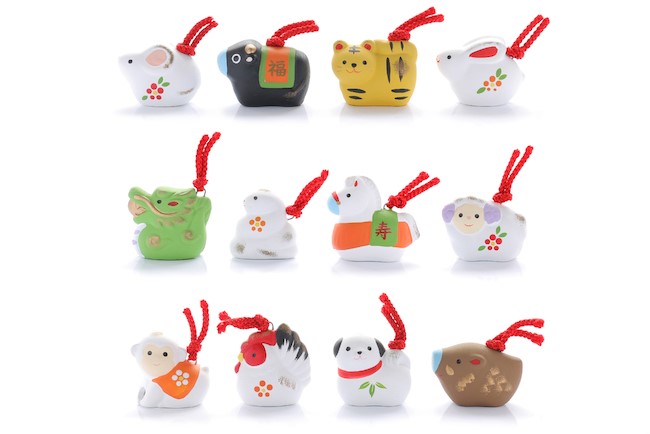The Japanese Zodiac: Unleash the Fun of This New Year Tradition

This page contains affiliate links.
The Japanese zodiac has a rich history and unique features that include a fascinating blend of Chinese and Japanese influences. While some aspects are based on the Chinese zodiac, many other aspects and stories are purely Japanese in origin. Learn more about this lesser-known aspect of Japanese culture and how it shapes the country's traditions and customs from the zodiac animals to the celebrations they inspire. In this guide, we go over the differences between Chinese and Japanese zodiacs, what the animals are, and their origin stories.
Origin of the Japanese Zodiac
The origin of the zodiac and the accompanying animals can be traced back to ancient China. During these times, China was predominantly an agricultural country with farming making up a large percentage of both the economy and domestic consumption. Creating a system to follow the change of seasons and weather throughout a single year made it easier for farmers to plan their farms and work with the seasons. While it is unknown exactly when the custom was brought to Japan, it is thought to be before the Nara Period (710-784AD).
How the Number & 12 Animal Names Were Decided
The system of time measurement introduced in China divided time into 12 periods. This was due to the rotation of Jupiter, which was considered to be an important planet in Ancient China. Jupiter took 12 years to rotate around the celestial sphere, so the Chinese Zodiac was divided into 12 parts. This was then reflected in the division of months, days, and more.
Each of the divisions was given a Chinese name and reading to make it easy to understand and remember for the population. This is why they were named after animals.
The Story Behind the Japanese Zodiac
A popular story explains why certain animals were chosen for the zodiac and in what order. According to the tale, the gods announced that the first 12 animals to offer New Year greetings would be assigned a place in the zodiac. All the animals were excited and wanted to be in the calendar. One version claims that the rat, knowing he was small and might struggle to get a place, tricked the cat by giving him the wrong date. The cat arrived a day late and as a result, missed the chance to be in the zodiac.
Some versions say the animals competed in a race, and the rat didn't wake up the cat in time as he promised. In both versions, the cat missed out due to the rat's deceit, and that's why cats chase rats to this day.
Difference Between the Chinese and Japanese Zodiac
As mentioned before, the origin of the Japanese Zodiac is found in the system of the Chinese Zodiac. However, there are some differences between the two calendars, including which animals appear in them.
In the Chinese Zodiac, the pig is the 12th animal. According to the Japanese Zodiac, this place was taken by a wild boar. A similar replacement occurred in regards to the ram or goat, in 8th place. In the Japanese calendar, this animal is more definitively known to be a sheep, rather than the ambiguous ram or goat.
The most significant difference is that the Chinese Zodiac is based on the lunar year. While the Japanese Zodiac may once have used this system, it has been based on the Gregorian solar year for a long time. Therefore, the Japanese New Year is celebrated on the same day as the Western world, January 1st, rather than the later Lunar New Year in late January.
Japanese Zodiac Animals, Signs & Meanings

There are twelve animals of the Japanese Zodiac, and each corresponds to specific years and is said to encompass certain qualities. There are several positive and negative characteristics to each animal. Here are the key features of each zodiac animal in order.
1. Rat 子 (ne)
The rat is the first animal of the zodiac. After hearing the story about the rat and cat, it is easy to see why the rat is considered resourceful and ambitious. They are also energetic and outgoing. Some negative aspects can be greed and rudeness, side-products of some of the more positive characteristics.
2. Cow 牛 (ushi)
The cow or ox is one of the most useful animals in agriculture and so was considered with great respect in ancient China. The ox is considered patient and hard-working, willing to put in a lot of effort to achieve their goals. They are trustworthy and strong-willed. However, sometimes this can lead to stubbornness and a lack of flexibility or unwillingness to adapt to changing situations.
3. Tiger 寅 (tora)
The tiger is highly significant in many Asian cultures, including both Chinese and Japanese cultures. The tiger is considered brave, passionate, and spirited. They can be wise and often make great leaders. However, they can also be hot-tempered, unpredictable, and impulsive.
4. Rabbit 卯 (u)
The rabbit is one of the more popular zodiac signs with many positive associations. People born in the year of the rabbit are considered calm, gentle, and elegant. They avoid conflict and are often sensitive. However, this can make them vulnerable to being tricked or talked into things.
5. Dragon 辰 (tatsu)
The dragon is one of the most powerful animals in the zodiac and is treated with great respect. Dragons are said to be charismatic, inspiring, and generous. It is said that the dragon comes later in the zodiac than many other animals because it stopped on the way to help others. Dragons are often confident and strong. Sometimes this strong personality can mean they are short-tempered and unpredictable. Dragons are generally considered to be great leaders.
6. Snake 巳 (mi)
The snake is an interesting zodiac animal, lacking the negative associations that it receives in Western culture. The snake is thought to be wise and intelligent, able to assess situations carefully and from various angles. The snake is financially lucky and money matters often work out in the end for a person born under this year. Due to its quiet nature, however, the snake can be considered cold and indifferent.
7. Horse 午 (uma)
People born in the year of the horse tend to be quite free-spirited and independent. They are flexible, quick to adapt, often charismatic, and sociable. However, they can sometimes be quick-tempered and impatient. It is easy for them to become demotivated and their social nature can be overwhelming for some other zodiac signs.
8. Sheep 未 (hitsuji)
The sheep is considered one of the most creative of the zodiac signs—artistically talented and passionate. They are usually kind and gentle people, with a peaceful nature. Many are group-oriented and try to avoid conflict. Sometimes this gentle nature can lead to indecisiveness and a lack of conviction.
9. Monkey 申 (saru)
The monkey is an interesting zodiac animal, as it is considered one of the smartest yet also very erratic. They are smooth and intelligent, great problem-solvers, and very inventive, yet can be short-sighted and inconsiderate of the effects of their actions on those around them. The monkey can also sometimes be conceited and manipulative of other people.
10. Rooster 酉 (tori)
People born in the year of the rooster are opinionated and outspoken. They aren’t afraid to speak their mind and are very independent. They are also very diligent and devote a lot of effort to any task they put their mind to. However, this can sometimes backfire as they can be very disappointed and upset if something they are working towards doesn’t pan out. They can sometimes be over-confident, which can exacerbate this issue.
11. Dog 戌 (inu)
The dog is considered the most loyal of the animals. It can sometimes be cautious when forming relationships with others, but once the bond is formed, the dog will be unwaveringly loyal. Dogs are also kind and generous to those around them. Another quality associated with the dog is honesty, sometimes to a fault. Being overly honest sometimes causes conflict with others. They can also sometimes be unnecessarily stubborn.
12. Wild Boar 亥 (i)
The boar displays great honesty and work ethic. They are humble, genuine, and easily display affection to those around them. The boar can be symbolic of strength, both inner and outer as well as sincerity. However, the boar can be hot-tempered and quick to anger. They can also sometimes be naïve.
Japanese Near Year Zodiac Traditions
The Japanese Zodiac manifests in a number of during Japanese New Year celebrations and traditions. Some of the most common customs during this time feature the zodiac animals heavily. These include sending nengajou (年賀状) or New Year’s cards which often show the zodiac animal of the upcoming year.
Another common tradition at New Years is hatsumoude (初詣) or the first shrine visit of the year. Many shrines stay open all night on New Years Even with celebrations and food stalls as people come to pay their first visit. This can also occur any time early in the year for those who don’t wish to go out in the winter cold of the early morning.
Many of the shrines will be decorated with items featuring the new zodiac animal and some will feature ema (絵馬), decorative wooden plaques, with the animal on them.
Shrines usually offer omikuji (おみくじ), or fortunes, year-round but they are especially popular around the New Year. As this is the most popular time, many shrines will make limited edition omikuji featuring the zodiac animal of the new year.
For those who collect goshuin (御朱印), or red stamp seals, from shrines and temples, this is a perfect time of year for collecting special limited edition goshuin, often with the zodiac animal incorporated.
Add Some Excitement to Your Life and New Year Celebrations
The Japanese Zodiac calendar and the twelve corresponding animals have had a great impact on Japanese New Year traditions. From the resourceful rat to the charismatic dragon, each zodiac animal holds its own unique traits and characteristics. Dive deeper into Japanese culture by incorporating these fun and fascinating zodiac traditions into your New Year celebrations.
Eager for more fun and interesting content on Japanese culture? Be sure to read our many other articles here!
















